![]()
![]()
![]()
Use LEFT and RIGHT arrow keys to navigate between flashcards;
Use UP and DOWN arrow keys to flip the card;
H to show hint;
A reads text to speech;
147 Cards in this Set
- Front
- Back
|
Pulmonary-Renal syndrome:
|
Characterized by Rapidly progressive glomerulonephritis and pulmonary hemorrhage.
RPGN: hematuria, red cell casts, renal insufficiency Pulmonary alveolar hemorrhage with hemoptysis and/or diffuse pulmonary infiltrates with increased Co2 diffusion capacity |
|
|
Diagnosis of pulmonary-renal syndrome:
|
Definitive diagnosis requires lung or kidney biopsy with EM or IF studies as well as evaluation of serum for specific antibodies.
Possible causes: Goodpasture Disease Microscopic Polyangiitis (MPA) Churg-Strauss Vasculitis Wegener’s Granulomatosis |
|
|
Goodpasture's Disease:
|
Anti-glomerular basement membrane antibodies attacking kidneys and lungs
Severe, even fatal alveolar hemorrhage Rapidly progressive glomerulonephritis with crescentic histology and acute and often permanent renal failure IgG directed against NC1 domain of the alpha-3 chain of type IV Collagen within the GBM T cells from these patients react against the same domain Complement activation Antibody mediated Type II hypersensitivity |
|
|
Pathology of goodpasture's disease:
|
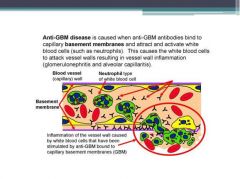
|
|
|
Goodpasture's renal biopsy:
|
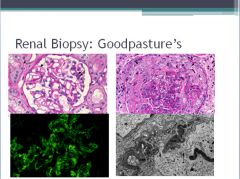
Normal is at top left
|
|
|
Goodpasture's Lung biopsy:
|

|
|
|
Treatment of Goodpasture's Disease:
|
Methylprednisone
Cyclophosphamide Plasmapheresis |
|
|
Microscopic Polyangiitis
|
Usually multi organ involvement but may be renal-limited
Pulmonary findings: hemoptysis, pulmonary alveolar hemorrhage Hematuria, RBC casts, renal failure Segmental Necrotizing glomerulitis with crescents Pauci-immune (little or no Ig deposition) Anti-neutrophil cytoplasmic antibodies of the P type(P-ANCA) directed against myeloperoxidase **Inflammation of capillaries in the glomeruli and alveoli due to release of neutrophil toxins** |
|
|
Treatment of microscopic polyangiitis:
|
Cyclophosphamide
Glucocorticoids Induction regimen followed by maintenance regimen |
|
|
Churg-Strauss syndrome:
|
Vasculitis and fibrinoid necrosis of small arteries
Nodular swellings and aneurysms of vessels Asthma Fever *Hypereosinophilia in blood and tissues* Renal findings: Vasculitis and glomerulitis |
|
|
Churg-Strauss eosinophilic vasculitis:
|
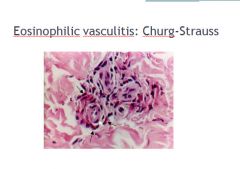
|
|
|
Treatment of Churg-Strauss syndrome:
|
Steroids
Cytotoxic Agents IV Ig Plasmapheresis |
|
|
Wegener's granulomatosis:
|
Systemic vasculitis
Necrotizing granulomatous inflammation Involvement of upper and lower respiratory tract and kidneys Lower airway involvement: dyspnea, hemoptysis, alveolar hemorrhage Renal involvement: Hematuria, RBC casts, renal failure Segmental Necrotizing glomerulitis with crescents Pauci-immune (little or no Ig deposition) |
|
|
Skin and lung findings in Wegener's granulomatosis:
|

|
|
|
Wegener's granulomatosis Kidney biopsy:
|

|
|
|
Diagnosis and treatment of Wegener's granulomatosis:
|
Diagnose with:
C-ANCA antibodies (directed against serine proteinase 3 ) Treat with: Cyclophosphamide Glucocorticoids Induction regimen followed by maintenance regimen |
|
|
Causes of cough:
|

|
|
|
Cough variant asthma:
|
COUGH VARIANT ASTHMA WILL OFTEN PRESENT AFTER AN INFECTION/URI
SPIROMETRY AND PHYSICAL EXAM ARE OFTEN NORMAL RESOLUTION WITH EMPIRIC LOW DOSE SHORT ACTING BETA AGONIST MAY BE DIAGNOSTIC HISTORY AND RESPONSE ARE CRITICAL METHACHOLINE* CHALLENGE TESTING IS RECOMMENDED BY SOME * *Methacholine will trigger an inflammatory response in a hypersensitive airway |
|
|
What is the most common cause of hemoptysis?
|
Chronic bronchitis
|
|
|
Differentiating between bronchitis and pneumonia:
|

|
|
|
Chest X-ray of left upper lobe pneumonia:
|
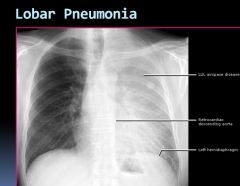
Left upper lobe: Loss of the cardiac border with preservation of the left diaphragm shadow with some bronchial airspaces showing.
|
|
|
Outpatient treatment of CAP:
|

|
|
|
CAP performance measures:
|
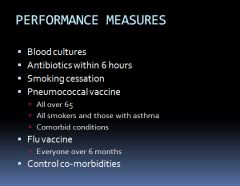
|
|
|
Characteristics of lung abscess:
|

|
|
|
Lung abscess risk factors
|

|
|
|
Differential for lung cavitation:
|

The thicker the cavity wall is the more likely it is to be cancer.
TB cavitations develop in the posterior segment of the upper lobes. |
|
|
More differential for lung cavitation:
|
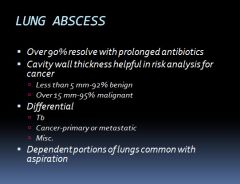
|
|
|
Risk of TB Infection:
|

People who actually get an active infection usually convert from negative to postive skin test within a 2 year period.
|
|
|
Which cytokine do Th1 cells produce to activate macrophages in response to TB infection?
|
IFN-g
|
|
|
TB granuloma formation:
|

INF-g is required for a granuloma to form…produced by T cells (in an AIDS patient who lacks T cells you can have infection without granuloma formation)
|
|
|
TB caseous necrosis:
|

|
|
|
Primary vs. Secondary TB lung pathology:
|
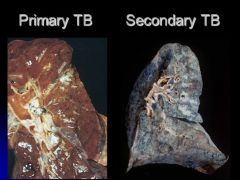
Primary TB = Ghon complex, focus of infection that drains out of regional lymph nodes
Secondary TB = Ghon’s lesion in lower portion of upper lobe with active TB infection in the apex of the upper lobe due to increased oxygen content at apex; most commonly from reactivation of dormant bacteria and not a second infection |
|
|
X-ray of reactivation TB
|

Left upper lobe cavitary infiltrates.
|
|
|
What is the best test to detect TB?
|
AFB/Smear
|
|
|
Meaning of a positive PPD test
|

|
|
|
What type of lung cancer occurs most in non-smoker's?
|
Adenocarcinoma
|
|
|
KRAS and EGFR testing in lung cancer:
|
Can have one but not the other; can effect treatment course
|
|
|
Classification of bronchogenic lung cancers:
|

|
|
|
Characteristics of squamous cell lung cancer:
|

|
|
|
Squamous cell lung cancer histology:
|

|
|
|
Adenocarcinoma in Situ of the lung:
|

Frequently associated with EGFR mutation, therefore responsive to tyrosine kinase inhibitors
|
|
|
Adenocarcinoma of the Lung:
|

|
|
|
Histology of adenocarcinoma of the lung:
|

|
|
|
Large cell carcinoma of the lung:
|
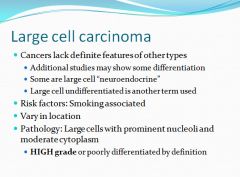
|
|
|
Histology of large cell carcinoma of the lung:
|

|
|
|
Small cell carcinoma of the lung:
|

|
|
|
Small Cell carcinoma histology:
|
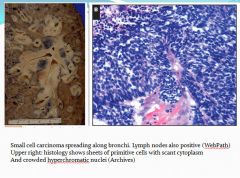
|
|
|
Typical presentation of lung cancers:
|
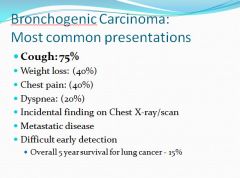
|
|
|
Symptoms of spreading lung cancer:
|

|
|
|
Symptoms of advanced lung cancer:
|

|
|
|
Histology of Squamous vs. Adenocarcinoma of the lung:
|

|
|
|
Lung cancer treatments:
|

|
|
|
Metastasis to the lungs:
|

|
|
|
Imaging of mesothelioma:
|

|
|
|
Bronchial Carcinoid tumors of the lungs:
|

|
|
|
Hamartoma tumors of the lung:
|

|
|
|
Laryngeal Cancer:
|

|
|
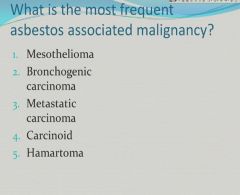
|
Bronchogenic carcinoma
|
|

|
small cell carcinoma
|
|

|
Female asian non-smoker with adenocarcinoma
|
|
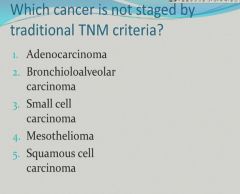
|
Small cell carcinoma
|
|
|
Histology of mesothelioma:
|
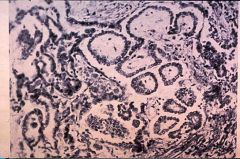
Mesothelioma can look glandular or spindled, or both.
Will frequently track out/follow the needle path of thoracentesis! |
|
|
Transudate vs Exudate pleural effusion:
|

|
|
|
Criteria for transudate vs. exudate:
|

|
|
|
What is the most common cause of a bloody effusion?
|
Carcinoma
Also trauma and pulmonary infarction are possible causes - anything that damages the mesothelium lining. |
|
|
What causes chylothorax?
|
Trauma to the thoracic duct, or blockage of the duct by a tumor
|
|
|
Transudate histology
|

Will see some mesothelial cells and some PMNs
|
|
|
Exudate histology
|

Mesothelial lining is damaged and integrity is lost.
|
|
|
Transudate Etiology
|

|
|
|
Exudate etiology
|

|
|
|
Signs and symptoms of pleural effusion:
|

|
|
|
PA xray of pleural effusion:
|

Blunting of costophrenic angle
|
|
|
Lateral xray of pleural effusion:
|

|
|
|
Parapneumonic effusion:
|

|
|
|
Empyema:
|

A large amount of fibrinopurulent exudate overlies the pleura of the entire lung. Note the marked fibrous pleural thickening along the right edge indicative of a longstandng chronic inflammatory process. Fibrous "walling off" of areas of chronic empyema may require surgical intervention.
|
|
|
Diagnosis of an empyema:
|

|
|
|
Stages of empyema:
|

|
|
|
Management of an empyema:
|

A pleural effusion with a fever should be investigated with thoracentesis
|
|
|
Spontaneous Pneumothorax primary vs. secondary
|
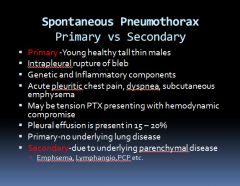
|
|
|
Management of a pneumothorax:
|

|
|
|
Tuberculous Pleurisy:
|

|
|
|
Medicare criteria for home oxygen therapy:
|
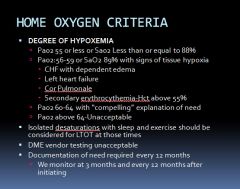
|
|
|
Complications of nasal oxygen:
|

|
|
|
Lung transplant contraindications:
|
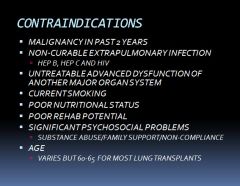
|
|
|
Genetic basis of cystic fibrosis:
|

|
|
|
Mutations of CFTR in cystic fibrosis:
|
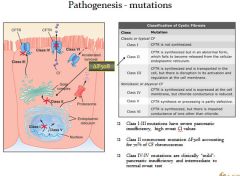
|
|
|
Defective ion transport in cystic fibrosis:
|
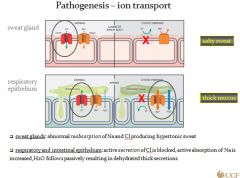
|
|
|
How is cystic fibrosis inherited?
|
Autosomal recessive pattern
|
|
|
Respiratory symptoms of cystic fibrosis:
|

|
|
|
Pathology/Histology of CF:
|

|
|
|
Chest X-ray of CF:
|
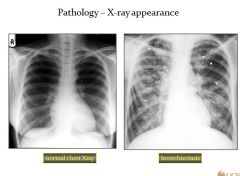
Note flattening of diaphragm due to mucus plugging of airways and trapping of air
|
|
|
Pancreatic symptoms of CF:
|

|
|
|
GI symptoms of CF:
|

|
|
|
Other symptoms of CF:
|

|
|
|
CFPANCREAS mnemonic for symptoms of CF:
|
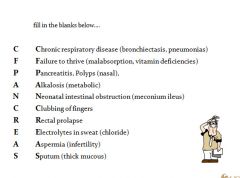
|
|
|
Sweat test for diagnosis of CF:
|
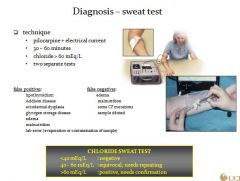
|
|
|
Criteria for diagnosis of CF:
|

|
|
|
Treatment of CF:
|

|
|
|
What is the median survival for CF patients currently?
|
37.5 years
|
|
|
What is the most common cause of mortality in CF patients?
|
Cardiopulmonary manifestations
|
|

|
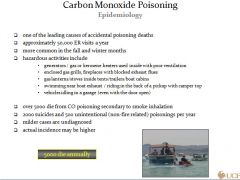
|
|

|

|
|

|

|
|

|

|
|

|

|
|

|
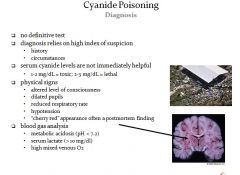
|
|

|

|
|
|
Hydrogen sulfide poisoning:
|

|
|

|

|
|
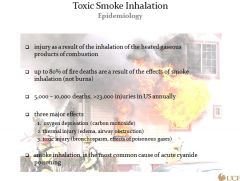
|

|
|

|

|
|
|
Summary from toxins lecture:
|
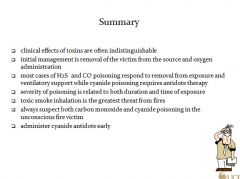
|
|
|
Incidence of respiratory distress syndrome:
|

Insulin acts as an "anti-surfactant"
|
|
|
At how many weeks of gestation is a premature baby able to survive?
|
At 24 weeks; some surfactant is being produced at this time
|
|
|
Pathophysiology of RDS:
|

|
|
|
Properties of surfactant:
|

|
|
|
Types of surfactant:
|
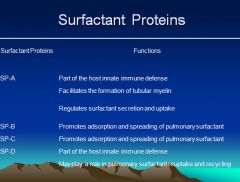
|
|
|
Surfactant deficiency causes these problems:
|
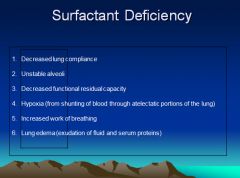
|
|
|
Respiratory symptoms of RDS:
|
Respiratory symptoms:
Usually present at birth and worsen over first days of life. Tachypnea- respiratory rate >60 Grunting Intercostal/ subcostal retractions Apnea (ominous sign) |
|
|
Chest X-ray of baby with RDS:
|

Classic RDS described as ground glass appearance with distal air bronchograms
May appear as “white out” lung with loss of cardiac and /or diaphragm borders Indistinguishable from congenital pneumonia, especially GBS infection. |
|
|
Treatment of RDS with surfactant replacement therapies:
|

|
|
|
Retinopathy of prematurity is caused by what?
|
Giving 100% oxygen to a premature baby
|
|
|
Steroid therapy to prevent RDS:
|
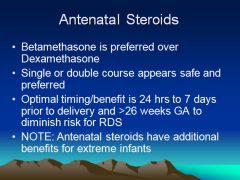
|
|

|
All of the above
|
|

|
Prenatal steroids would have made no difference
|
|

|
Surfactant therapy has significantly improved survival
|
|

|
Natural or artificial
|
|
|
Causes of respiratory failure:
|

|
|
|
Explanation of causes of respiratory failure:
|

|
|
|
Examples of V/Q mismatch:
|

|
|
|
West zones of the lung:
|

Zone 1 is a big dead space due to high alveolar pressure and decreased perfusion.
Zone 3 is the opposite where arterial pressures are greater than alveolar pressure. So a patient on a ventilator with positive pressure may have a created huge zone 1! |
|
|
Ventilatory failure criteria:
|
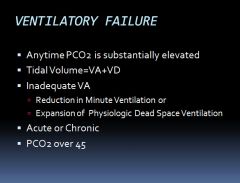
VA = alveolar ventilation
VD = dead space ventilation |
|
|
Hypoxic respiratory failure criteria:
|

|
|
|
Common causes of respiratory failure:
|

|
|

|
ARDS
|
|
|
Goals of ventilatory support:
|

|
|
|
Non invasive mechanical ventilation:
|
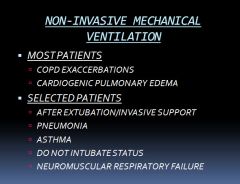
|
|
|
Non invasive PEEP
|

|
|
|
Intubation guidelines:
|

|
|
|
Controlled mechanical ventilation:
|
Mandatory Tidal Volume and Rate
No spontaneous breaths No drive or muscle capability |
|
|
Assist-control ventilation:
|
Tidal Volume and Minimum Rate are Pre-set and Guaranteed
If patient initiates a breath/TV delivered Ensures Minimum minute ventilation Sensitivity of machine to trigger set Tidal Volume |
|
|
Intermittant mandatory ventilation:
|
Pre-Set TV and RR
Patient allowed to breath spontaneously between mechanical breaths Lowers mean airway pressure |
|
|
Pressure support ventilation:
|

|
|
|
Common ventilator settings:
|

|
|
|
PEEP:
|

|
|
|
Complications of ventilation:
|

|
|

|

|

